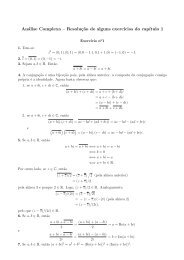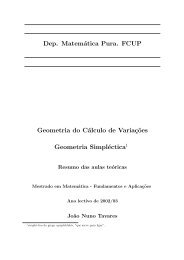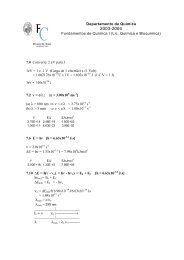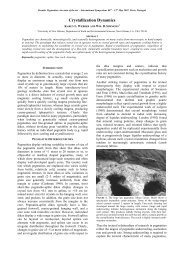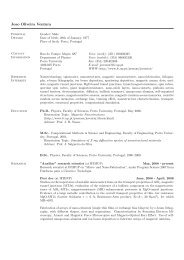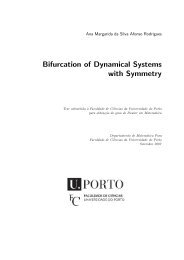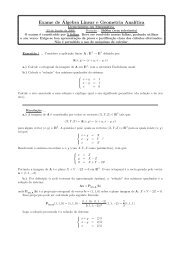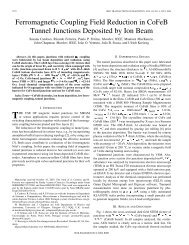REE-mineral phases replacing helvite, niobian-rutile, bastnäsite-(Ce ...
REE-mineral phases replacing helvite, niobian-rutile, bastnäsite-(Ce ...
REE-mineral phases replacing helvite, niobian-rutile, bastnäsite-(Ce ...
Create successful ePaper yourself
Turn your PDF publications into a flip-book with our unique Google optimized e-Paper software.
Granitic Pegmatites: The State of the Art – International Symposium. 06 th – 12 th May 2007, Porto, Portugal.<br />
<strong>REE</strong>-<strong>mineral</strong> <strong>phases</strong> <strong>replacing</strong> <strong>helvite</strong>, <strong>niobian</strong>-<strong>rutile</strong>, <strong>bastnäsite</strong>-(<strong>Ce</strong>) from<br />
alkaline pegmatites of Mount Malosa, Zomba District, Malawi<br />
ALESSANDRO GUASTONI 1 & FEDERICO PEZZOTTA 2<br />
1 Dept of Mineralogy and Petrology, University of Padova, corso Garibaldi, 37 – 35137 Padova (Italy), alessandro.guastoni@unipd.it<br />
2 Department of Mineralogy, Museum of Natural History, corso Venezia, 55 – 20121 Milan (Italy), federico.pezzotta@comune.milano.it<br />
ABSTRACT<br />
The niobium-yttrium-fluorine (NYF) miarolitic, granitic, alkaline pegmatites, crystallized at shallow depth (~1Kb),<br />
associated to the Zomba-Malosa Giurassic pluton are characterized by an unique <strong>mineral</strong>ogy. This study, focused <strong>mineral</strong><br />
replacement processes in pegmatitic cavities, such as <strong>helvite</strong> replaced by quartz + zircon + thorite; <strong>bastnäsite</strong>-(<strong>Ce</strong>) by<br />
cerianite and <strong>niobian</strong>-<strong>rutile</strong> by rhabodphane-(<strong>Ce</strong>) + <strong>bastnäsite</strong>-(<strong>Ce</strong>) + cerianite + monazite-(<strong>Ce</strong>).<br />
Keywords: Mount Malosa, alkaline pegmatites, <strong>bastnäsite</strong>,<strong>helvite</strong>, <strong>niobian</strong>-<strong>rutile</strong>.<br />
INTRODUCTION<br />
The Zomba-Malosa pluton, emplaced approximately<br />
113 Ma, is composed by qz-syenite and peralkaline<br />
granite and belongs to the Chilwa-alkaline province of<br />
Cretaceous age (Woolley, 1987; Eby et al., 1995). The<br />
associated niobium-yttrium-fluorine (NYF) miarolitic,<br />
granitic, alkaline pegmatites are characterized by an<br />
unique <strong>mineral</strong>ogy including aegirine, arfvedsonite,<br />
cerian-pyrochlore, fluorite, hingganite-(Y), Nb-Ta-Y<br />
oxides, niobophyllite-astrophyllite, <strong>REE</strong>-carbonates,<br />
several Na-Be-Zr-silicates, xenotime-(Y) and zircon<br />
(Guastoni et al., 2003). These pegmatites outcrop close<br />
to the summit of Mount Malosa (~2000 m.a.s.l.) and<br />
they are subhorizontal, strongly miarolitic and often<br />
contain large, metric cavities. The rock textures and the<br />
<strong>mineral</strong> assemblage indicate that these alkaline<br />
pegmatites crystallized at shallow depth. Indeed recent<br />
structural investigation by single-crystal X-ray<br />
diffraction performed on aegirines from Mount Malosa<br />
collected in the cavities indicate the crystallization<br />
occurred at ~1kb and at temperature of 300-400 C°.<br />
(Secco et al., submitted). In addition the studies on<br />
fluids inclusions in quartz crystals from miarolitic<br />
cavities of Mount Malosa estimate entrapment pressure<br />
at 130 MPa (Zajacz et al., 2006).<br />
REPLACEMENT PROCESSES<br />
This study, performed by X-ray diffraction and SEM-<br />
EDS analysis, is focused to <strong>mineral</strong>s replaced that occur<br />
in the pegmatitic cavities at Mount Malosa. Elsewhere<br />
<strong>mineral</strong> replacements were frequently observed in<br />
alkaline pegmatites: for example at Lovozero Massif<br />
and at Mount Saint Hilaire and (Pekov, 2000; Horváth<br />
& Gault, 1990). The more common substitutions<br />
observed at Mount Malosa are goethite + albite after<br />
parisite, quartz after epididymite, quartz + albite after<br />
apatite?, (or milarite? or phenakite?) and illite after<br />
<strong>bastnäsite</strong>. Moreover a number of additional unknown<br />
<strong>mineral</strong>s, usually forming large pluricentimetric<br />
euhedral crystals, occur in the cavities and they show<br />
replacements by <strong>REE</strong>-<strong>mineral</strong>s and Zr- Th silicates.<br />
FIGURE 1. Backscattered image of an ex-<strong>helvite</strong> replaced by quartz<br />
(dark grey) euhedral zircon crystals (grey) hosting thorite at the core<br />
(bright white).<br />
Tetrahedral (“pseudoctahedral”) pluricentimetric brown<br />
crystals of a <strong>mineral</strong> having the typical crystal<br />
morphology of <strong>helvite</strong> is replaced by quartz + zircon +<br />
thorite + subordinate <strong>niobian</strong>-<strong>rutile</strong> (Fig.1). Yellowbrownish<br />
prismatic, columnar crystals of <strong>bastnäsite</strong>-(<strong>Ce</strong>)<br />
show a core composed by brown-orange vitreous<br />
<strong>bastnäsite</strong>-(<strong>Ce</strong>): the remnant portion of the crystals is<br />
composed by an earthy, spongy overgrowth of cerianite<br />
+ <strong>bastnäsite</strong>-(<strong>Ce</strong>). Specimens containing replacements<br />
after <strong>helvite</strong> and after <strong>bastnäsite</strong>-(<strong>Ce</strong>) were observed<br />
together associated with microcline and aegirine in the<br />
pegmatite cavities. Another significant<br />
pseudomorphosis is after the tabular, prismatic crystals<br />
of <strong>niobian</strong>-<strong>rutile</strong>. These crystals show an outer earthy,<br />
spongy brownish rim composed by rhabodphane-(<strong>Ce</strong>) +<br />
minor <strong>bastnäsite</strong>-(<strong>Ce</strong>). Internally relics of <strong>niobian</strong>-<strong>rutile</strong><br />
are embedded and partially replaced by <strong>bastnäsite</strong>-(<strong>Ce</strong>)<br />
+ cerianite + monazite-(<strong>Ce</strong>). Locally submillimetric<br />
cerian-pyrochlore and zircon crystals line small<br />
secondary vugs of these crystals.<br />
CONCLUSIVE REMARKS<br />
Replacements occur at the late stage of the<br />
crystallization and involve rare accessory <strong>phases</strong><br />
including beryllium silicates, <strong>REE</strong>-carbonates and<br />
<strong>niobian</strong>-<strong>rutile</strong>. Quartz, albite, zircon + thorite generally<br />
replace beryllium silicates. <strong>REE</strong>-carbonates
Granitic Pegmatites: The State of the Art – International Symposium. 06 th – 12 th May 2007, Porto, Portugal.<br />
FIGURE 2. Backscattered image of <strong>niobian</strong> <strong>rutile</strong> replaced by<br />
<strong>bastnäsite</strong>-(<strong>Ce</strong>) + cerianite (grey) and monazite-(<strong>Ce</strong>) (lighter grey).<br />
Minor bright white areas are composed by relics of <strong>niobian</strong>-<strong>rutile</strong>.<br />
are replaced by iron and cerium oxides: it is not yet<br />
clear if parisite!<strong>bastnäsite</strong> replacement also occurs.<br />
Niobian-<strong>rutile</strong> shows complex substitutions processes<br />
mainly by phosphate and carbonates of cerium. Further<br />
studies are needed to address the complex geochemistry<br />
of alkaline fluids responsible for the destabilization of<br />
Be, Nb, and <strong>REE</strong> bearing rare accessory <strong>mineral</strong>s.<br />
REFERENCES CITED<br />
Eby, G.N., Roden-Tice, M., Krueger, H.L., Ewing, W., Faxon, E.H. &<br />
Woolley, A.R. (1995) Geochronology and cooling history of the<br />
northern part of the Chilwa alkaline province, Malawi. Journal of<br />
African Earth Science, 20, 275-288.<br />
Guastoni, A., Pezzotta, F. & Demartin, F. (2003) Le pegmatiti di<br />
Zomba-Malosa. Rivista Mineralogica Italiana, 27, 66-77.<br />
Horváth, L. & Gault R.A. (1990) The <strong>mineral</strong>ogy of Mont Saint<br />
Hilaire, Quebec. The Mineralogical Record, 21, 281-359.<br />
Pekov, I.V. (2000) Lovozero Massif – History, Pegmatites, Minerals.<br />
Ocean Pictures Ltd., Moscow, Russia.<br />
Secco, L., Guastoni, A., Nestola, F., Redhammer, G. & Dal Negro, A.<br />
(Submitted) High-pressure formation imprinting in clinopyroxenes.<br />
A study case: the aegirine (NaFe 3+ Si2O6). American Mineralogist,<br />
submitted.<br />
Woolley, A.R. (1987) Litosphere metasomatism and the petrogenesis<br />
of the Chilwa Province of alkaline igneous rocks and carbonatites,<br />
Malawi. Journal of African Earth Science, 6, 891-898.<br />
Zajacz, Z., Halter, W.E., Pettke, T. & Guillong, M. (2006)<br />
Determination of fluid/melt partition coefficients by LA-ICPMS<br />
analysis of co-existing fluid and silicate melt inclusions. Abstract<br />
from 4 th Swiss Geoscience Meeting, Bern.






